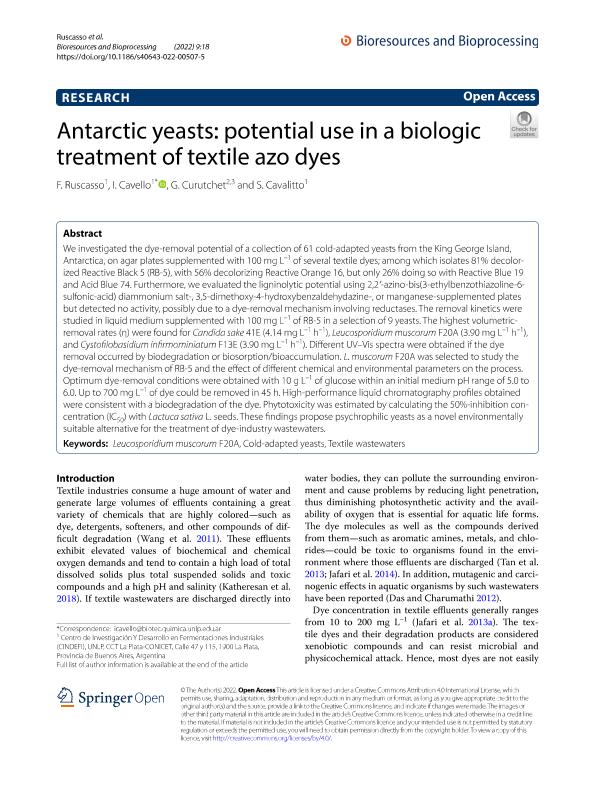Artículo
Antarctic yeasts: Potential use in a biologic treatment of textile azo dyes
Ruscasso, Maria Florencia ; Cavello, Ivana Alejandra
; Cavello, Ivana Alejandra ; Curutchet, Gustavo Andres
; Curutchet, Gustavo Andres ; Cavalitto, Sebastian Fernando
; Cavalitto, Sebastian Fernando
 ; Cavello, Ivana Alejandra
; Cavello, Ivana Alejandra ; Curutchet, Gustavo Andres
; Curutchet, Gustavo Andres ; Cavalitto, Sebastian Fernando
; Cavalitto, Sebastian Fernando
Fecha de publicación:
12/2022
Editorial:
Springer
Revista:
Bioresources and Bioprocessing
ISSN:
2197-4365
Idioma:
Inglés
Tipo de recurso:
Artículo publicado
Clasificación temática:
Resumen
We investigated the dye-removal potential of a collection of 61 cold-adapted yeasts from the King George Island, Antarctica, on agar plates supplemented with 100 mg L–1 of several textile dyes; among which isolates 81% decolorized Reactive Black 5 (RB-5), with 56% decolorizing Reactive Orange 16, but only 26% doing so with Reactive Blue 19 and Acid Blue 74. Furthermore, we evaluated the ligninolytic potential using 2,2ʹ-azino-bis(3-ethylbenzothiazoline-6-sulfonic-acid) diammonium salt-, 3,5-dimethoxy-4-hydroxybenzaldehydazine-, or manganese-supplemented plates but detected no activity, possibly due to a dye-removal mechanism involving reductases. The removal kinetics were studied in liquid medium supplemented with 100 mg L–1 of RB-5 in a selection of 9 yeasts. The highest volumetric-removal rates (η) were found for Candida sake 41E (4.14 mg L–1 h–1), Leucosporidium muscorum F20A (3.90 mg L–1 h–1), and Cystofilobasidium infirmominiatum F13E (3.90 mg L–1 h–1). Different UV–Vis spectra were obtained if the dye removal occurred by biodegradation or biosorption/bioaccumulation. L. muscorum F20A was selected to study the dye-removal mechanism of RB-5 and the effect of different chemical and environmental parameters on the process. Optimum dye-removal conditions were obtained with 10 g L–1 of glucose within an initial medium pH range of 5.0 to 6.0. Up to 700 mg L–1 of dye could be removed in 45 h. High-performance liquid chromatography profiles obtained were consistent with a biodegradation of the dye. Phytotoxicity was estimated by calculating the 50%-inhibition concentration (IC50) with Lactuca sativa L. seeds. These findings propose psychrophilic yeasts as a novel environmentally suitable alternative for the treatment of dye-industry wastewaters.
Palabras clave:
COLD-ADAPTED YEASTS
,
LEUCOSPORIDIUM MUSCORUM F20A
,
TEXTILE WASTEWATERS
Archivos asociados
Licencia
Identificadores
Colecciones
Articulos (IIIA)
Articulos de INSTITUTO DE INVESTIGACION E INGENIERIA AMBIENTAL
Articulos de INSTITUTO DE INVESTIGACION E INGENIERIA AMBIENTAL
Articulos(CINDEFI)
Articulos de CENT.DE INV EN FERMENTACIONES INDUSTRIALES (I)
Articulos de CENT.DE INV EN FERMENTACIONES INDUSTRIALES (I)
Citación
Ruscasso, Maria Florencia; Cavello, Ivana Alejandra; Curutchet, Gustavo Andres; Cavalitto, Sebastian Fernando; Antarctic yeasts: Potential use in a biologic treatment of textile azo dyes; Springer; Bioresources and Bioprocessing; 9; 1; 12-2022; 1-12
Compartir
Altmétricas



